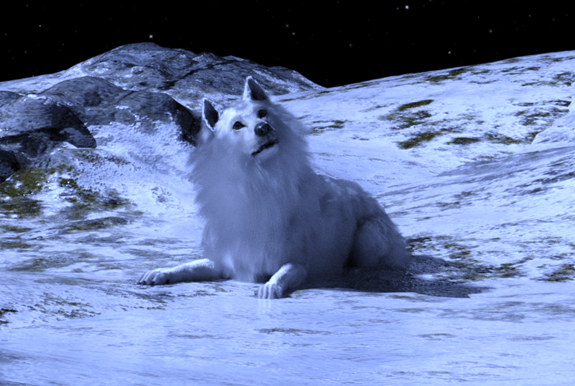
4. The Glacier-Wolves.

Ganymede, the largest moon in the Solar System, is actually larger than Mercury, the smallest planet. Ganymede orbits Jupiter, and like her sister moons Europa and Io, she too plays host to a pack of unique wolves.
Ganymede has a vast ocean, most of which is underground, or under-ice, but there are some areas where the ocean is uncovered, and it is in these coastal areas where the icy land meets the sea most of the Glacierwolves live.
The inland wolves are very similar to the Icewolves of Europa, but the coastal wolves couldn’t be any more different. They are larger creatures, and live in very large communities. They survive by eating Ganymedean Plankton, a collection of organisms that spend most of their time floating around the warmer ocean bed (which is actually just around the core of the moon), but occasionally they float to the surface to take in oxygen.
The Glacierwolves are expert swimmers, aided by their webbed feet and gill-like features that appear just below their shoulders whenever they dive beneath the waves. Their eyes and nose cover with a film which keeps the water out as soon as they go under water, but the film also allows them to see the bio-luminescence of the plankton as it floats in the dark, cold waters. The Glacierwolves merely swim with their mouths open, and take in as much plankton as they need.
There is an atmosphere on Ganymede, but it is very thin, and mostly oxygen and ozone, so after the Glacierwolves have had their fill of plankton, they return to their dens and caves to sleep. They spend a lot of the time sleeping, sometimes for up to two months at a time, and do so in numbers so as to keep warm. The temperatures at night on Ganymede plummet substantially, and considering the daytime temperatures range between -297 and -171 degrees Fahrenheit, it gets rather chilly.
At certain times of the year, during these mass hibernations, the dens become alive with singing as the Glacierwolves sing together; their calls not entirely dissimilar to the Firewolves of Io. However, the Glacierwolves appear to sing for fun, and not to lure pray. They awaken suddenly, presumably due to changes in the pull from Ganymede and Jupiter’s magnetic fields, and respond to it with melodic harmonies.
Due to the magnetic pull, the sounds of the Glacierwolves’ song carry throughout all of Jupiter’s moons, but whether the singing from the wolves on the other moons is in response to this remains to be seen.
These aquatic animals don’t appear to mix with the other wolves from the Jovian system and further afield, but are legendary in their own right. There is one slight twist to their ‘tale’, however, although it is yet to be confirmed; some of the Glacierwolves have developed the ability to live solely under water, and their hind legs and tails have fused into one large fish-like tail enabling them to swim deeper, even to the core bed of the Ganymede Ocean. These Glacierwolves, alas, are yet to be seen, although the aquatic sounds from their singing resonate through the depths and darkness of the waters whilst their regular cousins blissfully sleep.

Next time… the Microwolves of Varuna

Would you like to leave a comment?